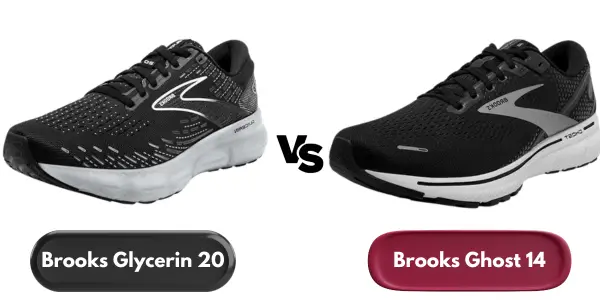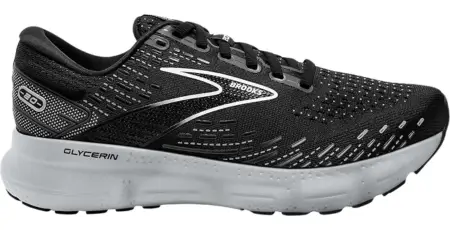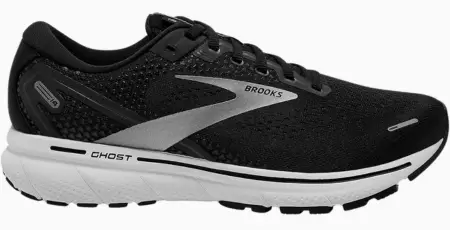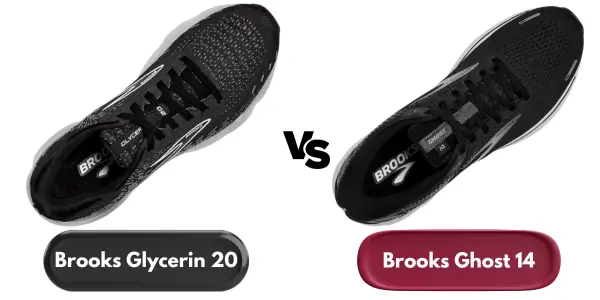Brooks Ghost vs Glycerin Differences Comparison
Last Updated: January 01, 2025 | Author: Jake Thompson
Over 50% of runners experience an injury every year, a statistic that underscores the importance of proper footwear. As someone who's been in the thick of the running community for years, I've seen firsthand how the right shoe can make all the difference.
The Brooks Ghost and Glycerin are two of the most talked-about contenders in the cushioning category, and I've had my fair share of miles in each. They're both designed to offer the support and comfort needed to protect runners from the relentless impact of the road, but they cater to different types of runners.

The Glycerin, with its plush feel, seems to cradle the foot, whereas the Ghost strikes a balance between softness and springiness. I'm here to take a closer look at how these models compare, factoring in everything from their construction to the way they handle in the long run.
Stay with me as we unpack the details that could very well influence your next shoe purchase and possibly your running performance.
While exploring Brooks Ghost, you might also be interested in seeing how it stacks up against Asics Nimbus in our detailed comparison about Brooks Ghost vs Asics Nimbus.
Table of Contents:
- Key Takeaways
- Table: Brooks Ghost 14 vs Glycerin 20
- Pros & Cons
- Design
- Performance
- Breathability
- Heel-to-Toe Drop
- Midsole Differences
- Upper Construction
- Comfort
- Cushioning
- Fit and Feel
- Weight Comparison
- Final Verdict
- Frequently Asked Questions
Key Takeaways
- - The Ghost 14 is a more affordable option as it is often on sale.
- - The Glycerin 20 is recommended for long-distance running with its plush ride and luxurious upper.
- - The Ghost 14 provides stability and is suitable for short-tempo runs.
Table: Brooks Ghost 14 vs Glycerin 20
 |
 |
|
|---|---|---|
| Feature | Brooks Glycerin 20 | Brooks Ghost 14 |
| Terrain | Road | Road |
| Pace | Daily running | Daily running |
| Toebox | Medium | Medium |
| Pronation | Overpronation, Supination | Neutral Pronation |
| Cushioning | Balanced | Plush |
| All-day Wear | ✓ | ✓ |
| For Beginners | ✓ | ✓ |
| Jogging | ✓ | ✓ |
| Treadmill | ✓ | - |
| Walking | ✓ | ✓ |
| Arch Support | Stability | Neutral |
| Heel to Toe Drop | 10mm | 12mm |
| Weight | 298g | 280g |
| Collection | Brooks Glycerin, Brooks Glycerin Gts | Brooks Ghost |
| Widths Available | Normal, Wide, Narrow | Normal, Wide, X-Wide |
| Foot Condition | Plantar fasciitis, Flat feet | N/A |
| Orthotic Friendly | ✓ | ✓ |
| Removable Insole | ✓ | ✓ |
| Sustainable | - | ✓ |
| Distance | Long distance | Long distance |
| For Big Guys | ✓ | - |
| Breathable | ✓ | - |
| Comfortable | ✓ | ✓ |
| For Heavy Runners | ✓ | - |
| Maximalist | ✓ | ✓ |
| Strike Pattern | Heel strike | Heel strike |
| Flexibility | Moderate | Flexible |
| Arch Type | Low arch | High arch |
| Material | Mesh | Mesh |
| Season | Summer | Winter |
| Release Date | Jul 2022 | Jul 2021 |
| Forefoot Height | 28mm | 24mm |
| Heel Height | 38mm | 36mm |
| Price |
Pros & Cons
Brooks Glycerin 20
Pros:
- - Supreme Comfort: Renowned for its plush cushioning, especially in the heel area, making it ideal for long-distance runners who prioritize comfort.
- - Responsive Cushioning: Features the new DNA LOFT v3 foam, which is nitrogen-infused, providing a soft yet responsive feel underfoot.
- - Stability Options: Available in a GTS version, offering GuideRails technology for those who need extra stability.
- - Durable Outsole: The outsole is made from soft-blown rubber, providing good grip and durability on various surfaces.
Cons:
- - Weight: Slightly heavier compared to the Ghost 14, which might not be ideal for runners who prefer a lighter shoe.
- - Breathability: The upper is a bit thick, making it less suitable for hot weather or runners who prefer highly breathable shoes.
- - Price: Generally more expensive, which might be a consideration for budget-conscious runners.
Brooks Ghost 14
Pros:
- - Balanced Cushioning: Offers a firmer, more responsive ride, making it a versatile choice for various running conditions.
- - Breathability: Features an updated mesh upper, providing better breathability and comfort, especially in warmer conditions.
- - Lightweight: Lighter than the Glycerin 20, appealing to runners who prefer a more agile and less bulky shoe.
- - Eco-Friendly: Made with at least 30% recycled materials in the upper, appealing to environmentally conscious runners.
Cons:
- - Less Plush: Some runners might find the cushioning less plush compared to the Glycerin 20, which could be a downside for those seeking maximum comfort.
- - Midsole Firmness: The firmer midsole might not be suitable for runners who prefer a softer, more cushioned feel underfoot.
- - Toe Box Fit: Some runners might find the toe box a bit snug or prefer a roomier fit, especially for longer runs.
Design
When analyzing the design features of the Brooks Glycerin 20 vs Ghost 14, it's clear that both shoes exhibit distinct structural elements tailored to their intended running experiences.
The Ghost 14's upper is crafted with an engineered mesh that ensures breathability, while strategic synthetic overlays provide structure.
In contrast, the Glycerin 20 boasts a luxurious upper, integrating a more seamless design that wraps the foot in plush comfort.
Both model's heel counters are padded, offering a stable and secure fit.
The midsole is where they diverge significantly; the Ghost 14 is designed with firmer cushioning for improved energy return, whereas the Glycerin 20's midsole delivers plush cushioning, prioritizing a softer, more forgiving ride.
Performance
When assessing the performance of both running shoes, breathability and heel-to-toe drop are critical factors.
I've noticed that the Ghost 14's updated air mesh offers superior breathability, which is essential for maintaining comfort during long summer runs.
Meanwhile, the heel-to-toe drop differences, with Ghost 14 at 12mm and Glycerin 20 at 10mm, could significantly influence the biomechanics and overall performance of runners, according to our review.
| Feature | Brooks Ghost 14 | Brooks Glycerin 20 |
|---|---|---|
| Cushioning Level | Maximum (3/3) | Medium (2/3) |
| Weight (Men's US M9/Women's US W7.5) | 10.1 oz / 8.9 oz | 9.9 oz / 9 oz |
| Heel to Toe Drop | 10mm | 12mm |
| Flexibility Rating | 4/5 | 4/5 |
| Breathability | Moderate (Less ideal for summer) | High (Better option for summer) |
| Stability | Neutral (GTS version available) | Neutral |
| Midsole Material | DNA LOFT v3 (Nitrogen-infused) | DNA LOFT v2 |
| Outsole Durability | High (Durable rubber) | High (Durable rubber) |
| Overall Comfort | High (Plush cushioning) | Moderate (Firm cushioning) |
| Suitability for Long Runs | Very Suitable | Suitable |
| Price Range | Generally more expensive | Slightly cheaper |
Breathability
Assessing the breathability of running shoes, specifically the Brooks Ghost 14 offers superior ventilation due to its updated air mesh upper, making it a more suitable choice for summer runs compared to the less breathable Glycerin 20. The Ghost 14's engineered mesh not only provides a structured fit but also enhances airflow throughout the shoe. This is critical for keeping feet cool and dry during intense workouts.
The Ghost 14's upper features moisture-wicking materials that help to draw sweat away from the skin. Strategically placed ventilation zones in the Ghost and Glycerin improve breathability and cooling, making them a versatile shoe choice during hot weather conditions.
On the other hand, while featuring a comfortable upper, the Glycerin lacks the same level of mesh integration, reducing its overall breathability.
Technically, the Ghost 14 is the clear winner in terms of breathable design, optimizing both comfort and performance for the runner.
Heel-to-Toe Drop
Considering the heel-to-toe drop is a critical factor in running shoe performance, the Ghost 14's 12mm drop contrasts with the Glycerin 20's 10mm, influencing runners' biomechanics and affecting overall stride and posture. A higher drop, like in the Ghost 14, typically provides a steeper angle for the foot, which can be beneficial for runners who strike with their heel first. Conversely, the Glycerin 20's slightly lower drop may encourage a more natural running position, potentially benefiting midfoot strikers.
Here's a technical comparison of the two:
| Feature | Brooks Ghost 14 | Brooks Glycerin 20 |
|---|---|---|
| Heel-to-Toe Drop | High drop (12mm) | Moderate drop (10mm) |
| Encourages Heel Strike | Yes | Promotes natural stride |
| Less DNA LOFT Cushion | Yes | Enhanced DNA LOFT cushion for comfort |
The choice between a high or moderate heel-to-toe drop in a running shoe like the Brooks Ghost vs Glycerin will hinge on individual comfort and biomechanical needs.
Midsole Differences
Delving into the midsole differences, it's clear that the Brooks Ghost 14's DNA Loft v2 provides a firmer, more responsive ride, whereas the Glycerin 20's DNA Loft v3 offers a noticeably softer cushioning.
The Ghost 14, with its firmer midsole, caters to runners seeking a blend of support and responsiveness, making it a versatile option for neutral daily training.
On the other hand, the Glycerin 20 is softer than the Ghost, which translates into a plush and luxurious underfoot feel, ideal for those long, easy miles where comfort is paramount.
- DNA Loft v2 in Ghost 14: Provides a firmer ride with increased energy return
- DNA Loft v3 in Glycerin 20: Enhances softness for a more cushioned experience
- Flex grooves: Engineered to promote a smooth ride and natural foot movement
These midsole differences clearly define each model's intended use and preference.
Upper Construction
When examining the upper construction of both Ghost and Glycerin running shoes, it's evident that each shoe offers a distinct approach to fit and comfort, employing engineered mesh materials and varying degrees of padding to cater to different preferences.
The Ghost 14 features synthetic overlays that enhance structure and durability while providing a snug fit without constricting movement. Its mesh is designed to be flexible yet supportive, striking a balance that promotes a secure lockdown during runs.
In contrast, the Glycerin 20 takes a more minimalist approach in its upper construction, with fewer overlays and a stretchy engineered mesh that adapts to the foot's shape.
Both models include a gusseted tongue, ensuring a comfortable fit and adding to the flexibility and secure feel of the shoe.
Comfort
When assessing the comfort, I closely examine the cushioning technologies used.
The Glycerin 20's use of DNA Loft v3 in its midsole provides a notably softer experience, which may translate to superior comfort during prolonged runs.
In contrast, the Ghost 14's firmer DNA Loft v2 cushioning aims to balance softness with responsiveness, potentially offering a more energized ride without compromising too much on comfort.
Cushioning
The cushioning systems of the Ghost 14 and Glycerin 20 are engineered to provide distinct levels of comfort and support, with Glycerin's DNA Loft v3 offering a notably softer experience compared to the Ghost's DNA Loft v2 material.
The Glycerin 20 is designed with a full-length DNA Loft v3 midsole, delivering a plush underfoot sensation that's ideal for those seeking a luxurious, softer ride.
In contrast, the Ghost 14, while still providing a neutral cushion, leans towards a firmer ride that balances cushioning with responsiveness.
- Full-Length DNA Loft Midsole: A significant feature in the Glycerin 20 for a consistently plush feel.
- Softer vs. Firmer Ride: Glycerin 20 offers a softer experience, while Ghost 14 focuses on a firmer, more responsive ride.
- Neutral Cushioning: Both models serve runners who need neutral support with varying cushion preferences.
Fit and Feel

Slipping into the Glycerin 20, I immediately notice the enveloping comfort of its plush interior, a stark contrast to the more structured feel of the Ghost 14. As a daily trainer, the Glycerin 20 caters to my preference for a forgiving embrace around my foot, with a generous fit that comes in regular and wide options. The upper contours smoothly to my foot's shape, especially around the forefoot, not constricting but offering a gentle, secure lockdown.
The Ghost 14, while still comfortable, presents a more dialed-in fit. It's structured in a way that feels more precise, which some runners might favor for faster paces. Both shoes accommodate various foot shapes, but the Glycerin's luxurious feel stands out for long, easy miles.
Weight Comparison
In comparing the Brooks Ghost and Glycerin, it's notable that the Ghost 14 is the lighter option, weighing in at 280g, whereas the Glycerin 20 tips the scales at a slightly heavier 298g. This weight comparison is significant for runners looking for either a more elegant shoe during training or one that provides a bit more substantial cushioning.
Here are some technical details to consider:
- - Brooks Ghost 14: Ideal for runners seeking a lighter version that offers a balance between responsiveness and cushioning.
- - Brooks Glycerin 20: Geared towards those who prefer a heavier, more cushioned shoe for long-distance training.
- - Impact on Performance: Lighter shoes like the Ghost may enhance speed and agility, while the Glycerin's added weight could offer better shock absorption.
Both models excel in their respective niches within the Brooks lineup.
For a comprehensive understanding of Brooks' offerings, see our Brooks Ghost vs Brooks Adrenaline article, offering a different angle for those interested in Brooks Ghost and Brooks Glycerin.
Final Verdict
Choosing between the Glycerin and Ghost is like deciding between a cozy bean bag and a versatile office chair! If you're all about cushioning and don't mind a bit of extra weight, the Glycerin 20 is like a comfy hug for your feet, perfect for those long, leisurely runs. It's your plush paradise! But, if you're looking for a shoe that's nimble, adaptable, and eco-friendly, the Ghost 14 is your trusty sidekick, ready for any pace or place. So, are you in the mood for luxurious comfort or versatile agility? Pick your pair and pave your path to running bliss! 🏃♂️👟✨
Frequently Asked Questions
1. What are the main differences between Brooks Ghost vs Glycerin running shoes?
Both running shoes differ mainly in their cushioning and feel. The Glycerin features a full-length DNA LOFT midsole for a softer, more luxurious ride, making it ideal for runners seeking extra comfort. In contrast, the Ghost 14 offers a more versatile and responsive experience, suitable for a variety of paces and surfaces. Both models provide a secure lockdown with padded heel counters, but the Glycerin is often considered the softer and bouncier shoe.
2. Which Brooks running shoe is better for slow-paced running in wet conditions?
For slow-paced runs in wet conditions, the Ghost 14 might be the better option due to its durable and consistent outsole which provides reliable traction on wet surfaces. The Ghost's outsole is designed with flex grooves for better adaptability, making it a versatile choice. However, the Glycerin is also capable in wet conditions, offering a secure and comfortable ride.
3. Are the outsoles of both the Glycerin 20 and Ghost 14 durable?
Yes, both the Brooks Glycerin and the Ghost feature durable outsoles. The Ghost and the Glycerin shoes are made with high-quality rubber that withstands wear and tear, incorporating grooves for flexibility and more comfortable ground contact. This durability makes them suitable for long-term use in various running conditions.
For those who love the durability of Brooks shoes for outdoor activities, exploring the best dive watches under $1000 could be your next step in gearing up.
4. Which shoe is recommended for runners who prefer soft and bouncy shoes?
Runners who prefer soft and bouncy shoes would likely favor the Brooks Glycerin. Its full-length DNA LOFT midsole is engineered to provide a plush, cushioned feel, delivering a bouncy and comfortable running experience. This makes the Glycerin particularly suitable for those who prioritize comfort and a softer ride
5. Some people find the Brooks Ghost 14 stiff compared to the Glycerin 20. Is this true?
The perception of stiffness varies among individuals, but generally, the Ghost 14 is considered slightly less plush than the Glycerin. While the Ghost 14 is designed to be versatile and responsive, the Glycerin focuses more on providing a soft, cushioned feel. Those who don’t like a stiff shoe might prefer the Glycerin for its softer midsole and more luxurious feel.
Share this:







